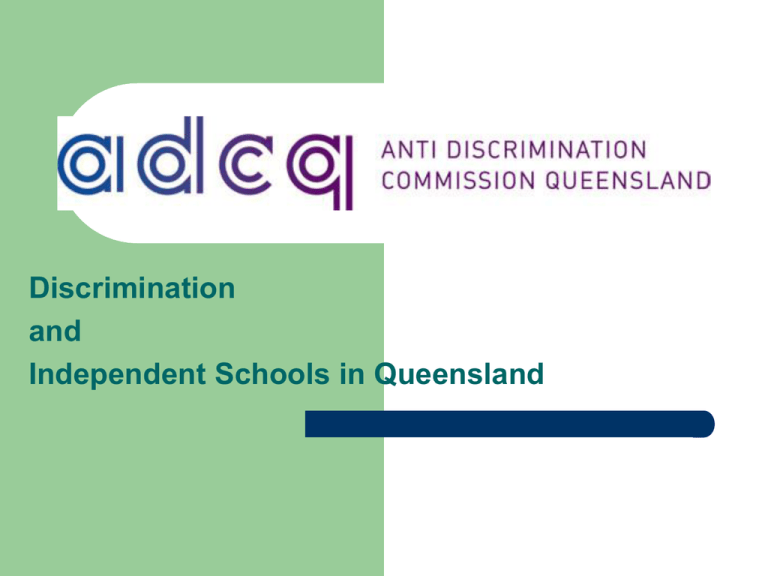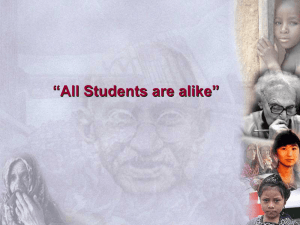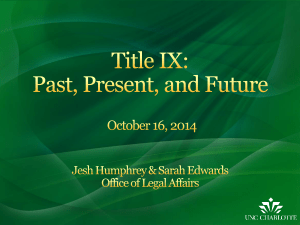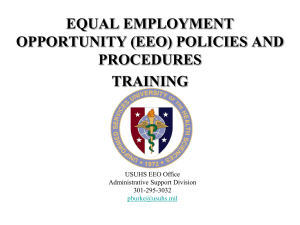
Discrimination
and
Independent Schools in Queensland
OVERVIEW
Introduction to the Anti-Discrimination
Act 1991
–
–
types of behaviour prohibited by the Act
areas of life where behaviours are prohibted
Vicarious Liability
Exemptions
Outcomes of complaints
Introduction to the AntiDiscrimination Act 1991
The Anti-Discrimination Act 1991
Makes unlawful –
Discrimination – direct & indirect (s8,10 &11)
Unnecessary Questions (s124)
Sexual Harassment (s118-120)
Victimisation (s129-131)
Public Vilification (s124A & s131A)
Discriminatory Advertising (s127-128)
and gives a person affected the right to lodge a
complaint with the ADCQ.
Discrimination
Discrimination must be:
1. on the basis of an attribute; and
2. in an area of activity
covered by the Act.
Discrimination can be:
Direct (section 10); or
Indirect (section 11).
The Attributes
Sex
Pregnancy
Breastfeeding
Family Responsibilities
Parental status
Relationship status
Sexuality
Gender identity
Lawful sexual activity
– ie. sex workers
Age
Impairment
Race
Religious belief or activity
Trade union activity
Political belief or activity
Association with a person
identified by an above
attribute
The Areas
Work – includes when applying for work
Education
Goods & services – includes access to public places
& facilities
Accommodation
Administration of State laws & programs
Superannuation & Insurance
Disposal of land, club membership, local government
members
Direct Discrimination
Elements of direct discrimination (s8 & 10):
1.
2.
3.
Attribute & Area
Worse treatment than another in same circumstances
A causal link between attribute & worse treatment
What is direct discrimination?
Complainant is targeted because of their attribute
Respondent’s motive is not relevant
Actions and/or words can be less favourable treatment
Indirect Discrimination
Elements of indirect discrimination (s8 & 11):
1.
2.
3.
Attribute & Area
A term with which the complainant cannot comply
A causal link between attribute & inability to comply
What is indirect discrimination?
Term may not be an express term & is often contained in a
policy or “across the board” practice
Respondent must show the term is reasonable
Respondent may not know the discriminatory impact & may not
know the complainant has the attribute
Unnecessary Questions
Cannot ask for information on which
discrimination might be based
Covers oral and written requests
Exemptions where authorised by law, court order, order
or award of industrial court or tribunal, industrial
agreement or order of the Anti-Discrimination Tribunal
Defence where respondent proves that the information
is reasonably required for a purpose not involving
discrimination
Sexual Harassment
Protects employees, students and everyone
at work, school and everywhere
Threshold elements of Sexual Harassment (s118-120):
Unsolicited physical intimacy; or
Unsolicited demand/request for sexual favours; or
A remark with sexual connotations relating to the
complainant; or
Other unwelcome sexual conduct of a sexual
nature in relation to the complainant
Sexual Harassment
And either
Intended to offend, humiliate or intimidate; or
done in circumstances where a reasonable person
would anticipate the possibility of the complainant
being offended, humiliated or intimidated
look at sex, age, race and impairment of the
complainant, relationship between the two
persons and any other circumstances.
Sexual Harassment can include:
×
×
×
×
×
×
×
Lewd comments, smutty jokes
Questions about private life, talk about your own sex life
Suggestive comments about person or their body
Asking for sex, requests for an intimate relationship
Touching and brushing against someone in a sexual way
Sexual assault
Offensive phone calls, showing a person sexual pictures o
emails, sexual SMS messages
Victimisation
Threshold elements of Victimisation (s129-131):
Act/threatened act to the detriment of the person complaining
of victimisation
Act or threat must be motivated by the victim, their associates
or relatives either
Refusing to breach the Act;
Alleging or intending to allege something which would be a
breach of the Act;
Being or intending to be involved in proceedings under the
Act; or
Being believed to be doing or intending to do one of the
above
Public Vilification
Threshold elements of vilification (s124A & 131A):
Public act
Incitement of others to hatred, serious contempt or severe
ridicule (real or potential incitement)
Person or group
On the ground of race, religion, sexuality or gender identity
Under s131A, also need actual threat to or incitement of
others to physically harm persons or property
Serious vilification
Vicarious Liability
Vicarious Liability (s133)
Employers
are also liable for contraventions of the Act
done by their workers or agents in the course of their work
Complaints can be made against either or both
Defence:
That the employers took reasonable steps to prevent the
discrimination or harassment including policies, training
and complaint procedures.
‘Reasonable steps’ for employers in preventing
discrimination and sexual harassment
Reasonable steps may include:
Policy
Induction and Training
Grievance Process
EEO Contact Officers
Monitoring Compliance with Policy
Relevant Exemptions to
Discrimination for independent
Schools
Exemptions
Some important exemptions include:
Religious Bodies
Work with children
Genuine occupational requirement
Unjustifiable hardship
Single sex, religion or impairment school
Religious Bodies (s109)
Act does not apply to:
training, education, ordination or appointment of
priests, ministers of religion or members of religious
orders
selection or appointment of persons to perform
functions or participate in religious observance
acts by religious body in accordance with religious
doctrine & necessary to avoid offending religious
sensitivities (exemption does not apply in work or education areas)
Work with children (s28)
Can discriminate against employee on basis of
lawful sexual activity or gender identity if
work involves care or instruction of minors
AND reasonably necessary to protect minors
physically, psychologically or emotionally
child sex offence conviction or if disqualified
from working with children under law
Genuine occupational requirement (s25 (1))
Can discriminate where imposing a genuine occupational
requirement on employee
Must be genuine, necessary for and relate to the job;
The section is objective in its terms
In practice:
Ask “Would the position be essentially the same if that
requirement was not included?”
–
If no, then it is a genuine occupational requirement.
Then ask “Is the complainant capable of performing that genuine
occupational requirement?”
–
If no, then discrimination against the complainant is
excused.
Genuine occupational requirement (s25 (2))
Can discriminate in a reasonable way for work
in a religious educational institution if a person(a) Openly acts in a way that is contrary to the
employer’s religious beliefs in a selection process, in
the course of work or connected to the person’s work;
AND
(b) It is a genuine occupational requirement that the
person acts consistently with the employer’s religious
beliefs
(Exemption doesn’t apply to age, race or impairment
discrimination)
Unjustifiable hardship (s35 & 44)
Can discriminate where:
–
–
The employee/student requires special services/facilities; &
The supply of the special services or facilities would impose
an unjustifiable hardship on the employer/educational
authority
Consider (s5) –
–
–
–
–
–
Nature of the special services or facilities
Number who would benefit or be disadvantaged
Nature of the benefit or detriment to all concerned
Financial circumstances of the employer/authority
Cost and disruption
School for single sex, religion or
impairment (s41)
Can discriminate if operate an educational
authority wholly or mainly for students of a
particular sex or religion or general or specific
impairment to exclude students who are not of the particular sex or
religion; or
Students who do not have a general or the
specific impairment.
Outcomes of Complaints under
the Anti-Discrimination Act
The Complaint Resolution Process
Written complaint received and
assessed within 28 days
Complaint accepted and
respondent notified
- optional written response
- can request early
conference
- date set for compulsory
conference within 6 weeks
Complaint not accepted
Complainant advised of reasons
for not accepting complaint
ff
fEarly conference held if all
parties agree & practical
ff
agree.
Compulsory conference held
Complaint rejected, based on
further information
Settlement reached
- agreement signed
- agreement filed at AntiDiscrimination Tribunal.
No settlement reached
- complaint may be referred to
Anti-Discrimination Tribunal
Complaint closed
Tribunal hears and decides the
complaint
Outcomes
Compensation
–
–
General damages – for hurt, humiliation, injury to feelings,
Special damages –expenses eg. medical and lost wages
Interest
Apology
Implementation of programs to eliminate
discrimination
Reinstatement/Enrolment
Declaration that an agreement is void
How much compensation is awarded
in a particular case?
I obo BI v State of Qld - $27,000 in general damages
- Highest amount for impairment discrimination against
a student in education
Walsh v St Vincent de Paul Society
- $25,000 general damages for religious discrimination
in work









